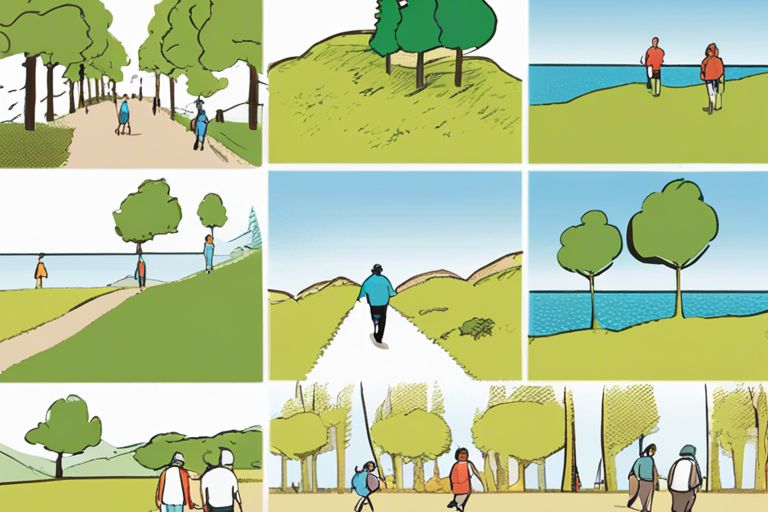Perambulating on various terrains can offer a plethora of advantages to your overall health and fitness. Walking on different terrains not only provides you with a change of scenery and a stimulating sensory experience, but it also challenges different muscle groups and can enhance your cardiovascular endurance. For instance, hiking on uneven and rocky trails can significantly improve your balance and proprioception, while walking on sand can engage muscles that aren’t typically activated on solid ground. Additionally, walking on uphill terrains may offer greater resistance training and help improve strength in your lower body. However, it’s important to be aware of the potential risks associated with certain terrains, such as the increased risk of ankle sprains on uneven ground or the potential for overuse injuries on hard surfaces. In this blog post, we will delve into the specific benefits and precautions to consider when walking on different terrains.
Physical Benefits of Varied Terrain Walking
Your body can experience numerous physical benefits when you walk on different terrains. The varied surfaces present unique challenges that can help improve your musculoskeletal strength, cardiovascular health, and overall fitness level.
Musculoskeletal Advantages
Walking on different terrains can provide a range of musculoskeletal benefits. When you walk on uneven surfaces such as gravel, sand, or hiking trails, your muscles are forced to work harder to maintain stability and balance. This can help strengthen your leg muscles, ankles, and feet, as well as improve overall stability and coordination. Additionally, walking uphill or downhill requires different muscle groups to work, which can help tone and strengthen your lower body.
Cardiovascular Enhancements
Engaging in varied terrain walking can also provide significant cardiovascular benefits. Walking on hilly or uneven surfaces can increase the intensity of your workout, resulting in a higher heart rate and increased calorie burn. This can help improve your cardiovascular endurance, leading to a stronger heart and improved overall cardiovascular health. The varying terrain also challenges your body to adapt to different conditions, which can enhance your cardiovascular fitness and make your heart and lungs stronger.
Psychological Benefits of Walking on Different Terrains
Clearly, the benefits of walking on different terrains extend beyond physical health. The varied landscapes and challenges that come with different terrains can have a significant impact on your psychological well-being.
Mental Health Improvements
Walking on different terrains can have a positive effect on your mental health. It can help reduce symptoms of anxiety and depression. Being surrounded by nature and experiencing different environments can lift your mood and reduce stress. The sense of accomplishment and confidence you gain from overcoming different terrains can also contribute to a more positive state of mind. Additionally, the social aspect of walking in different terrains can provide an opportunity for social interaction, further boosting your mental well-being.
Cognitive Function and Brain Health
Engaging in walking on different terrains can also benefit your cognitive function and brain health. The challenges presented by uneven terrain and varying landscapes require increased attention and concentration, which can help sharpen your focus and cognitive skills. Regular walking on different terrains can also have a positive impact on your memory and overall brain health. Studies have shown that exposure to natural environments can enhance cognitive function and improve your ability to concentrate.
Walking Terrain Types and Specific Benefits
Keep in mind that walking on different terrains can have unique effects on your physical and mental health. Here’s a breakdown of the specific benefits of walking on various terrains:
| Flat Surfaces | Benefits of Walking on Flat Surfaces |
| Hiking on Inclines | Advantages of Hiking on Inclines |
| Uneven Ground | Impact of Walking on Uneven Ground |
| Beach Walking | Beach Walking and Sand’s Resistance |
Benefits of Walking on Flat Surfaces
Walking on flat surfaces can provide a consistent, low-impact workout that is gentle on your joints. It allows you to maintain a steady pace and focus on your endurance and cardiovascular health. Additionally, walking on flat surfaces can be a great way to work on your posture and form, as the even ground allows for a stable and controlled stride.
Advantages of Hiking on Inclines
When you hike on inclines, you engage different muscle groups and burn more calories compared to walking on flat ground. The incline provides a greater challenge for your core and lower body, helping to improve strength and endurance. Additionally, hiking uphill can provide a mental boost as you conquer the challenge of the incline.
Impact of Walking on Uneven Ground
Walking on uneven ground forces your body to engage its stabilizing muscles, improving balance and coordination. It can also stimulate your sensory receptors, enhancing your proprioception and overall body awareness. However, it’s important to be cautious when walking on uneven terrain to avoid falls or injuries.
Beach Walking and Sand’s Resistance
Walking on the beach provides an extra challenge due to the resistance of the sand. This can intensify your workout and engage your leg muscles more than walking on a solid surface. The beach environment can also have a calming effect on your mind, as you enjoy the sounds and scenery of the ocean. However, it’s important to watch your step and be mindful of potential uneven or hazardous areas.

Practical Considerations for Terrain Walking
Not all terrains are created equal, and different environments come with their own set of challenges and considerations. When planning a walk in a specific terrain, it’s important to take into account factors such as safety, footwear, and gear to ensure an enjoyable and injury-free experience.
Safety Tips for Different Environments
When walking on different terrains, it’s important to be aware of the potential safety hazards that may be present. For example, when walking on rocky or uneven terrain, watch your step and use trekking poles for stability. In forested areas, be mindful of low-hanging branches and slippery moss-covered rocks. In desert environments, be sure to bring plenty of water, as dehydration can be a serious risk. When walking near bodies of water, such as beaches or riverbanks, be cautious of changing tides and currents. Always be prepared for unexpected weather changes, and let someone know your planned route and expected return time. Though the beauty of nature is alluring, it’s essential to prioritize your safety.
- Rocky or uneven terrain: Watch your step and use trekking poles for stability
- Forested areas: Be mindful of low-hanging branches and slippery moss-covered rocks
- Desert environments: Bring plenty of water to stay hydrated
- Beaches or riverbanks: Be cautious of changing tides and currents
Remember, it’s always better to be over-prepared than underprepared when walking in different terrains!
Footwear and Gear Recommendations
When walking on different terrains, having the appropriate footwear and gear can make a world of difference in your comfort and safety. For rocky or uneven terrain, opt for sturdy hiking boots with ankle support to prevent twisted or sprained ankles. In forested areas, consider wearing gaiters to protect your legs from scratches and insect bites. For desert environments, breathable and lightweight clothing, a wide-brimmed hat, and sunglasses are essential to protect yourself from the sun and heat. When walking near bodies of water, waterproof shoes and a change of socks can make your experience much more enjoyable. Remember that having the right footwear and gear can help prevent discomfort and potential injuries, allowing you to fully enjoy the benefits of walking on different terrains.
Conclusion: The Benefits of Walking on Different Terrains
Considering all points, it is clear that walking on different terrains can provide specific benefits for your overall health and well-being. Walking on different surfaces such as sand, grass, dirt, or pavement can help to strengthen different muscle groups, improve balance and stability, and provide a more varied and challenging workout for your body. Additionally, walking on uneven terrains can engage your core muscles and improve proprioception, which is important for overall fitness and injury prevention. By incorporating a variety of terrains into your walking routine, you can optimize the benefits and continue to challenge your body in new and beneficial ways.



